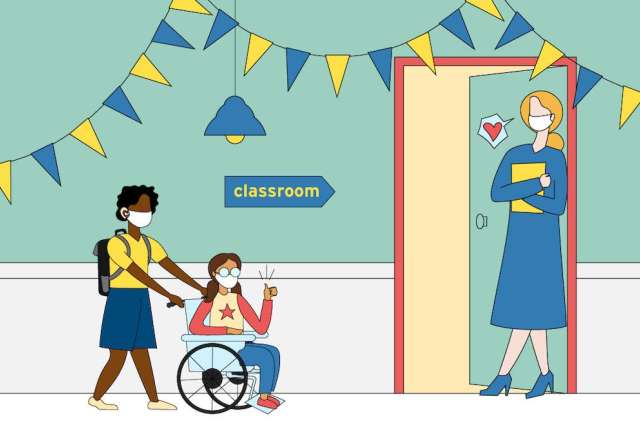As Southern California students head back to the classroom this fall, UCLA Health pediatrician Rebecca Dudovitz, MD, and developmental psychologist and researcher Emily Hotez, PhD, are urging schools, pediatricians and families to strategize together around helping students with disabilities transition back into the classroom environment.
In 2019, 7.1 million American children received special education in public schools, according to the National Center for Education Statistics. The pandemic led to the closure of school districts across the country, removing a major source of support for families of children with disabilities. When services went online, families of children with disabilities were largely left in limbo – taking on additional work and expenses to serve their kids’ needs.
Still, 10%-25% of students in the high-risk population, such as English learners, children in foster care, students experiencing homelessness and children with disabilities, have completely missed out on learning since the beginning of the pandemic, according to education researchers.
Barriers such as internet connectivity, access to devices, communication strategies including email and interpretation services, and access to adaptive instructional materials have made it especially challenging for children to keep up.
In addition to education, many children with disabilities require occupational, physical and speech therapy services, which typically occur in coordination with schools or in the school setting. As schools shifted to the online environment, several of these services did too.
“Schools are so much more than just a place where we teach our kids to read, write and do math,” Dr. Dudovitz says. “They are core to our communities, they’re the place where children have a chance to develop social-emotional skills and get exposure to other children and adults.”
Dr. Dudovitz, who is with the UCLA Children's Discovery and Innovation Institute at Mattel Children's Hospital, says since the pandemic started, she’s seen children regress in skills, behaviors and emotional health.
“I think that in many ways children's social-emotional health is one of the largest casualties of this pandemic,” she says. “I cannot tell you how many kids I'm seeing with depression and anxiety who were really thriving before.”
Dr. Hotez says all children are likely to have had mental health challenges due to the pandemic, but they may be particularly heightened among children with special needs.
“The stress of the school transition and loss of their typical routines may have exacerbated their mental health and behavioral challenges,” she says. “This puts the onus on schools to prioritize the implementation of clear routines at the time of the transitioning back into in-person learning.”
Dr. Hotez says before welcoming students back, it is critical for schools to reevaluate what’s working and what’s not.
“Research emerged during the pandemic suggests that services and supports like telehealth are not a “one size fits all” solution,” she says.
The same is true for educational support.
“There is likely not one solution to support all children, particularly children with disabilities who are so heterogeneous,” Dr. Hotez says. “Further complicating the situation, children with disabilities likely struggled during the pandemic for myriad reasons, including adjusting to remote learning, coping with potential social isolation and others. In effect, there is no simple fix to supporting children with disabilities.”
Oftentimes children with disabilities face greater challenges than their peers, such as social isolation, she says. “Schools should be purposeful in encouraging inclusion in the classroom and promoting social interaction,” she says, while also prioritizing virus mitigation techniques such as physical distancing.
The National Center for Learning Disabilities (NCLD) published a guide to accelerate learning for children with disabilities during and beyond the COVID-19 pandemic. Recommendations align with guidance from Drs. Dudovitz and Hotez, which are to educate students alongside their peers, redesign the curriculum and prioritize inclusion.
The spring served as an opportunity for families to address the specifics in their children’s Individualized Education Program (IEP), a legal document used to outline how the school will meet the child’s needs – such as specialized transportation, speech-language pathology and audiology services, psychological services, recreation, social work services and more.
“If the current IEP is not working for your child, ask for another IEP meeting to review sooner to come up with additional work-arounds,” Dr. Dudovitz says.
She says pediatricians will write letters for families that lay out the services that are important to the child's development or success in school. This can be a helpful tool during the IEP meeting process and for families not proficient in the English language.
“We view our role as a co-team member with parents to try to make sure that their children are thriving,” Dr. Dudovitz says.
Additional guidance for families helping their children transition back into the school environment includes:
Structured routine
“Having a structured routine at home lets kids know what is expected at each part of the day, which can be really helpful for them,” says Dr. Dudovitz.
As tools to communicate expectations and rules, routines help children feel secure, she says.
The Centers for Disease Control and Prevention recommends these three tips for creating structure at home:
1. Consistency – doing the same thing every time;
2. Predictability – expecting or knowing what is going to happen;
3. Follow-through – enforcing the consequence, such as “say what you mean and mean what you say.”
Examples of routines to implement are hand washing and consistent timing of meals and sleep.
“Screen time is something we know is not great for children's development and can affect their sleep,” Dr. Dudovitz says. According to a study in Research in Developmental Disabilities, common sleep issues in children with intellectual disabilities include trouble settling down at night, co-sleeping with a parent or caregiver and waking up very early in the morning.
Good sleep hygiene comes in part from enforcing consistent sleeping and waking times and establishing a soothing bedtime routine that includes turning off screens.
Dr. Hotez says adjusting to routines takes time, so using verbal reminders and visual cues can be helpful.
Environment
If applicable to your child, families and caregivers can make several small modifications to further support, such as being mindful of lighting for visually impaired children and clearing clutter and paths to prevent trip hazards.
“Having a quiet, consistent place for children to participate in school or other activities can be very helpful too,” Dr. Dudovitz says.
Lastly, she says it’s imperative for families to “hold onto those activities where their children really shine.”
“It's really important that kids still have joy and fun and are able to do things where they can be successful,” Dr. Dudovitz says.
Emotional support
She says parents can support their children’s social and emotional health by talking about feelings.
They can also model healthy coping strategies such as mediation for conflicts and mindfulness, and find ways to maintain social connections with peers during this period of transition.
As schools work toward safely reopening, Dr. Dudovitz emphasizes the importance of collaboration between schools, families and health care providers to acknowledge all the social, emotional and health needs that children carry with them.
“Addressing all of those needs are so important for those children to be successful.”
Find out more about the UCLA Children's Discovery and Innovation Institute.
More in this series:
Back to the classroom: It’s almost time to return – but is it safe?
Back to the classroom: COVID-19 forces new guidelines for school sports programs
Back to the classroom: For kids’ eating habits, a return to routine and nutrition
Back to the classroom: Communication is key for preparing children to return to school




